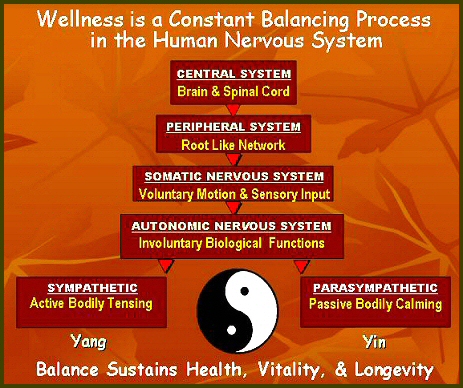Doctor Of Applied Meditation Psychology


Diagram by Dr. Andrew Shugyo Bonnici
All Rights Reserved

|
The human nervous system can be viewed as a pyramid. At the top of the pyramid is the central nervous system which includes the brain and spinal cord. The brain is the initiator and controller of our body movements. The spinal cord provides the brain access to incoming sensory information and nerve pathways through which the brain communicates with our various biological systems, organs, muscles and skeletal structure. The vast rootlike network of neuron cells that leave and enter the spinal cord are called the peripheral nervous system.
Information as nerve impulses reach the spinal cord through neural pathways and are transmitted to the brain. After the brain processes the information it sends signals that travel back down the spinal cord and leave as the peripheral nerve pathways to covey electrochemical messages to our biosystems, organs, and muscles. The spinal cord also acts as a coordinating center that is responsible for our simple body reflexes.
At the middle of the pyramid is the somatic nervous system that consists of certain peripheral nerve fibers that send messages to the central nervous system and nerve fibers that send messages to the skeletal muscles. This means that the somatic part of our nervous system conveys sensations from our eyes, ears, nose and other sensory organs to our brain which processes the sensory signals and then transmits nerve impulses via the somatic system to the skeletal muscles in order to permit voluntary control of our bodily movements. This dynamic sensory-motor process of the somatic nervous system is largely within our conscious awareness.
Our body's automatic biological processes are controlled by the autonomic nervous system which functions at the base of the pyramid and is the balancing point of the human nervous system as a whole. The nerves of the autonomic nervous system convey sensory impulses from the blood vessels, the heart and all of the organs in the chest, abdomen and pelvis to other parts of the brain. These autonomic electrochemical messages to the brain often do not reach our consciousness, but elicit largely automatic or reflex like responses that send nerve signals through the spinal cord and peripheral network to the heart, the vascular system, and all the organs of the body. This means that the vital functioning of the autonomic nervous system is normally done without your conscious intention, awareness, or control.
The autonomic nervous system consists of two opposing yet complementary systems :the sympathetic and the parasympathetic nervous systems. During the stressful conditions of living, the sympathetic nervous system quickens our heartbeat and breathing and coordinates changes in blood flow to various bodily organs The sympathetic nervous system is part of our "fight or flight" mechanism, which, when activated, is accompanied by the release of the hormone adrenaline (also known as epinephrine) that helps deliver a surge of power to our muscles in order to fight or get away in the face of immediate danger. During the many stressful conditions of our daily life, the reactive "fight or flight" mechanism also operates by way of the sympathetic system to temporarily inhibit digestion, immune system functioning, and tissue rejuvenation.
The parasympathetic nervous system has the opposite effect, preparing our bodies for a more restful state. This system is dominant when we are not feeling threatened and are ready for a relaxed state. The parasympathetic system conserves the body's energy resources, slows breathing and heart rate, decreases blood pressure, slows down metabolism, and is key in the process of relaxation and digestion. BASE OF THE NERVOUS SYSTEM PYRAMID The balanced operation and interplay between sympathetic and parasympathetic divisions of the autonomic nervous system keeps your body working properly in all situations by sustaining the healthy functioning of your organs, immune system, cellular oxygenation, digestion, general metabolism, and tissue rejuvenation. On the other hand, constant reinforcement of the sympathetic side of your autonomic nervous system, will disrupt the healthy functioning of your bodymind, make you more susceptible to illnesses, increase your vulnerability to the body's genetic predisposition to specific diseases, shorten your life span, and detrimentally impact the quality and fullness of your daily life, work satisfaction, and interpersonal relationships. Click Here to See a Diagram of How Stress Negatively Affects Your Health and Autonomic Nervous System Balance |